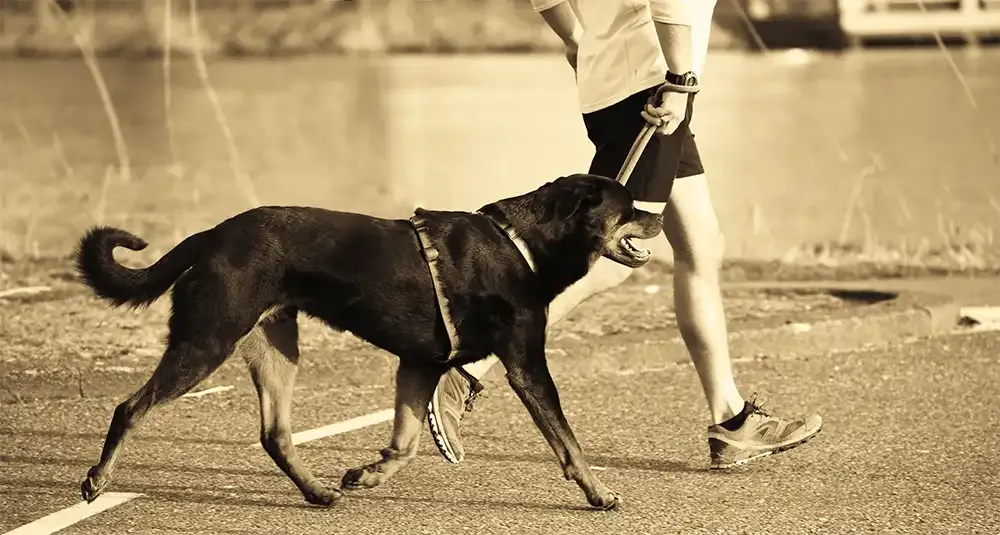Healthy tips for you and your dog

With the start of the New Year and the time for 'New Year Resolutions', Bark Busters Home Dog Training offers helpful tips to help you and your dog to keep fit and healthy.
Frequent activity plays a positive part for you and your dog's health. Keeping him active daily can benefit his muscles, bones, digestion, sleep, circulation, and general wellbeing. The bond between dog and human also encourages us to exercise more frequently and lose weight as part of our New Year resolutions.
Just like people, dogs need regular exercise and stimulation to keep them in good shape, both physically and mentally. Dogs crave human companionship and our emotional connection to our dogs help to motivate us and who better to choose as your exercise partner than your dog.
Tips to get started
Exercise needs vary from dog to dog, depending on the dog's breed, age, weight, and other factors. Therefore, consult with your vet before starting an exercise program with your dog, and be sure to consult with your own doctor about the right program for you.
- Take things slowly at first. Begin with a short session at a slow speed, then gradually increase the time, speed and distance.
- Your dog's paw pads will need time to toughen, so begin walking or running with him on soft surfaces such as grass.
- Avoid exercising your dog immediately before or after he's eaten. A full stomach may cause digestive upsets. Provide only small amounts of water before and directly after exercise.
Keep things interesting
Just letting your dog out in the backyard is not enough. Most dogs do not exercise themselves. Likewise, a brief daily walk may not be enough either. However, you can keep your dog both physically and mentally active on your daily walk by varying how you walk.
- Change the pace. Intermittently walk fast, slow, stop, etc. Your dog will come to see this as a game and will find the activity fun and stimulating.
- Change directions frequently. Go left, then right, turn in front of the dog, reverse direction, etc. Each time you make a change in direction, give a gentle flick of the lead to alert your dog you are about to change direction.
- Give obedience commands as you go. Stop and ask your dog to sit, lie down, etc.
- Be sensible. No matter how fit your dog is, his enthusiasm may overcome his common sense to know when to rest.
- Stop the games if your dog seems to be getting overly tired.
- Be sure he has access to fresh drinking water, but prevent stomach upset by limiting his intake if he is heavily panting.
- Don't forget to take poop bags to clean up after your dog.
Watch the weather
In winter
- Watch for signs of frostbite or hypothermia.
- Dress short-coated dogs in a dog coat.
- After a romp in the snow, wipe your dog's paw pads and between the toes to remove any snow, ice or road salts that may have accumulated there.
In summer:
- Exercise in the cool hours of the morning or late evening.
- Watch for signs of heat stroke.
- Beware of hot asphalt, which can damage your dog's paw pads.
Exercise his mind
Exercise your dog's brain, too. Just 15 minutes once or twice a day of teaching basic obedience can tire your dog's mind which is just as important to his overall health and happiness. Practice the basics such as sit, stay, fetch and walking on the lead to energise the lethargic dog and tire out the hyper dog.
With some practice, you can establish the leadership required for a satisfying stroll with your dog so you can both reap the benefits of good health, fitness and a happy emotional bond.
Recent Articles
- Easter Holidays - Keeping our dogs safe around food
- Horticultural Horrors for Hounds
- Understanding Dog Body Language
- Heatstroke in dogs - know the signs and what to do
- Preventing Separation Anxiety When Returning To Work
- Separation Anxiety
- Managing your time at home with your dog
- Top 10 Indoor Games for your Dog
- Working from home with your dog
- COVID-19 Social Distancing and Self Isolation
